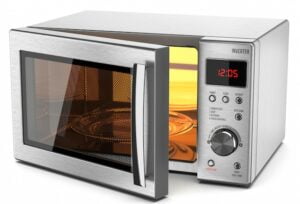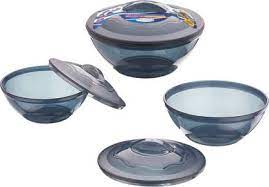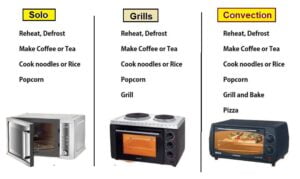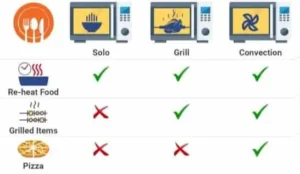What are the benefits of Microwave Cooking
How does the microwave work?
- Microwaves are produced inside the oven by an electron tube called a magnetron
- The microwaves are reflected within the metal interior of the oven where they are absorbed by food
- Microwaves cause water molecules in the food to vibrate, producing heat that cooks the food
- That’s why foods that are high in water content, like fresh vegetables, can be cooked more quickly than other foods
- Although heat is produced directly in the food, microwave ovens do not cook food from the “inside out
- When thick foods are cooked, the outer layers are heated and cooked primarily by microwaves
- Food cooked due to the conduction of heat from the hot outer layers

When should I stop using my microwave?
- Loud noises or alarm sounds are created at the end of the cooking cycle
- Check for sparks or smoke is there or not then you should stop using your microwave
Does Microwave radiate food?
- The microwave energy is changed to heat as it is absorbed by food and does not make food “radioactive” or “contaminated
Utensil for Microwave Cooking
Best Utensils for Cooking
- Glass and glass ceramic cookware is microwave safe as long as it doesn’t have gold or silver rims.
- There are several types of utensils that are safe for use in the microwave, including:
-
-
Glassware: Pyrex and other types of glass containers are safe to use in the microwave as long as they are labeled microwave-safe.
-
Ceramic dishes: Ceramic dishes are also safe to use in the microwave as long as they are labeled microwave-safe.
-
Plastic containers: Plastic containers labeled as microwave-safe can be used in the microwave, but it’s important to avoid containers that are not labeled as they may melt.
-
Paper plates and bowls: Paper plates and bowls are safe to use in the microwave as long as they are labeled microwave-safe.
-
Microwave-safe silicone utensils: Silicone utensils like spatulas, tongs, and steaming baskets are safe for use in the microwave.
-
- It’s important to follow the manufacturer’s instructions for each type of utensil when using them in the microwave to ensure that they are used safely and correctly.


Avoid Metal and Plastic for Microwave
- Metal cookware should not be used in a microwave
- Metal will not allow microwaves to penetrate and properly cook the food
- When convection cooking in a microwave convection oven, metal and foil can be safely used
- Microwaving plastic can release harmful chemicals like BPA and phthalates into your foods and drinks. Hence you should avoid microwaving plastic unless it’s labeled for this specific use
Different ways of Microwave Cooking
-
Heating and Reheating:
-
One of the most common uses of a microwave is to heat up leftovers or to reheat food that has been cooked previously
-
Microwaving is a quick and convenient way to heat up food, and it can be done in a matter of minutes.
-
-
Cooking Meals:
-
Microwaves can also be used to cook meals from scratch
-
There is much microwave-safe cookware for dishes, such as pasta, vegetables, and meat. Additionally, there are many microwave-safe recipes that are easy to prepare and delicious to eat.
-
-
Baking:
-
Microwaves can also be used to bake
-
There are many microwave-safe bakeware options available
-
Many delicious baked goods can be made in a microwave, such as cakes, muffins, and cookies.
-
-
Roasting:
-
Microwaves can also be used to roast food
-
This is a quick and convenient way to roast vegetables, such as potatoes and carrots, or to cook a whole chicken.
-
-
Grilling: Microwaves can also be used to grill food. This is a great option for
Electrical Parts of Microwave
- The cavity magnetron is the main component of a microwave
- The magnetron is an oscillator where electrons are emitted from a hot cathode and whirl past resonant cavities which are part of the anode at speeds that generate microwave energy
- The following are parts of microwave
-
- Magnetron
- High Voltage Transformer
- Waveguide
- Cooling Fan
- Cooking Cavity
- Turntable
- Power Cord
- Control panel

Circuit Diagram

Types of microwaves
-
Solo Microwave Ovens:
-
These are the most basic type of microwave ovens and are designed for simple heating and defrosting tasks.
-
-
Grill Microwave Ovens: As the name suggests, these microwaves come with a grill function, allowing you to grill food just like a traditional oven.
-
Convection Microwave Ovens:
-
Convection microwaves combine microwave cooking with convection heating, allowing you to bake and roast food just like a conventional oven.
-
-
Combination Microwave Ovens:
-
Combination microwaves are a combination of solo, grill, and convection ovens all in one appliance, offering versatility in cooking options.
-
-
Over-the-Range Microwaves:
-
These microwaves are designed to be installed above the stove, saving counter space and providing a seamless look to your kitchen.
-
-
Built-In Microwaves: Built-in microwaves are designed to be integrated into your kitchen cabinetry, offering a seamless and customized look.



Benefits of Microwave Cooking
- In today’s fast-paced world, people are looking for quick and convenient ways to prepare meals
- One such method is microwave cooking. Microwaving has been a popular cooking method for several decades and continues to be a staple in many kitchens\
- In this blog post, we will explore the benefits of microwave cooking and the different ways it can be used to prepare meals
- Microwave cooking offers a number of benefits, including:
-
Good Convenience:
-
Microwaves are very easy to use and allow for quick cooking and heating of food
-
This makes them ideal for busy individuals who don’t have much time to spend in the kitchen.
-
-
High Energy efficiency:
-
Microwaves use less energy than traditional ovens and cook food faster, making them an economical choice
-
-
Preserves nutrients:
-
Microwaves can cook food quickly, which helps to preserve the nutrients in the food
-
As Food items are not exposed to high temperatures for a long period of time, nutrients are preserved
-
-
Versatility
-
Microwaves can be used to cook a wide range of foods, including meat, vegetables, and even baked goods
-
Microwaves can be used for a variety of cooking tasks, including baking, roasting, grilling, and defrosting.
-
-
Easy cleanup:
-
Unlike traditional ovens, microwaves don’t create a mess in the kitchen
- Microwaves are easy to clean, as spills and splatters can be wiped away with a damp cloth.
-
-
Space-saving:
-
Microwaves are small and compact, making them a great choice for those with limited kitchen space.
-
Can Radiation from Microwave Ovens Injure the human body?
- Most injuries related to microwave ovens are the result of heat-related burns from hot containers, overheated foods, or exploding liquids
- Most injuries are not radiation-related. That said, there have been very rare instances of radiation injury due to unusual circumstances or improper servicing
- In general, microwave oven radiation injuries are caused by exposure to large amounts of microwave radiation leaking through openings such as gaps in the microwave oven seals
- However, FDA regulations require that microwave ovens are designed to prevent these high-level radiation leaks.

Conclusion
- Overall, microwave cooking is a convenient, energy-efficient, and versatile way to cook and heat food
-
There are several advantages to cooking with a microwave, including:
-
Speed: Microwaves are one of the fastest cooking appliances and can cook food much faster than traditional ovens.
-
Energy Efficiency: Microwaves use less energy compared to ovens and stovetops, making them a cost-effective option for cooking.
-
Convenience: Microwaves are easy to use and require minimal preparation, making them a convenient option for busy individuals who need to quickly prepare a meal.
-
Versatility: Microwaves can be used to cook a wide variety of foods, including vegetables, fruits, meats, and grains.
-
Precision Cooking: Many microwaves come with cooking presets, allowing you to cook food accurately and consistently with the touch of a button.
-
Easy to Clean: Microwaves are typically easy to clean and maintain, with removable trays and wipeable surfaces.
-
Space-Saving: Microwaves are compact and take up less space compared to ovens, making them a good option for small kitchens or apartments.
-


